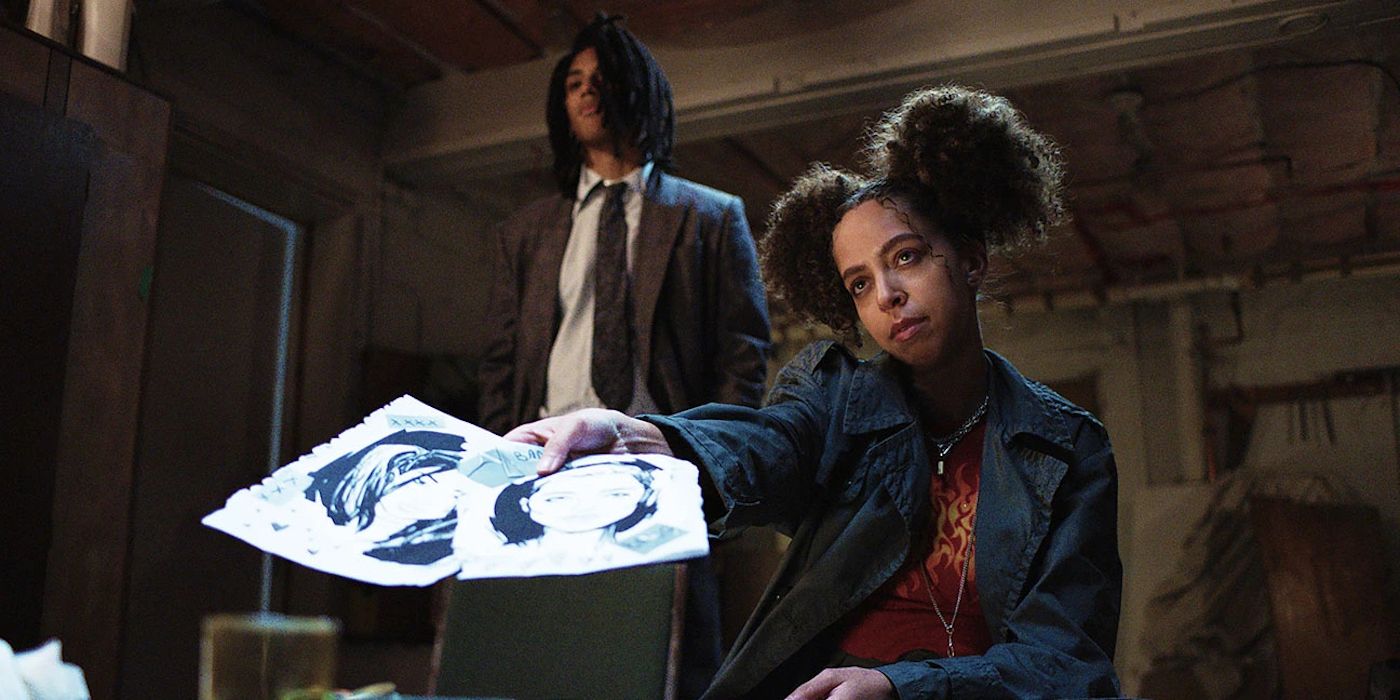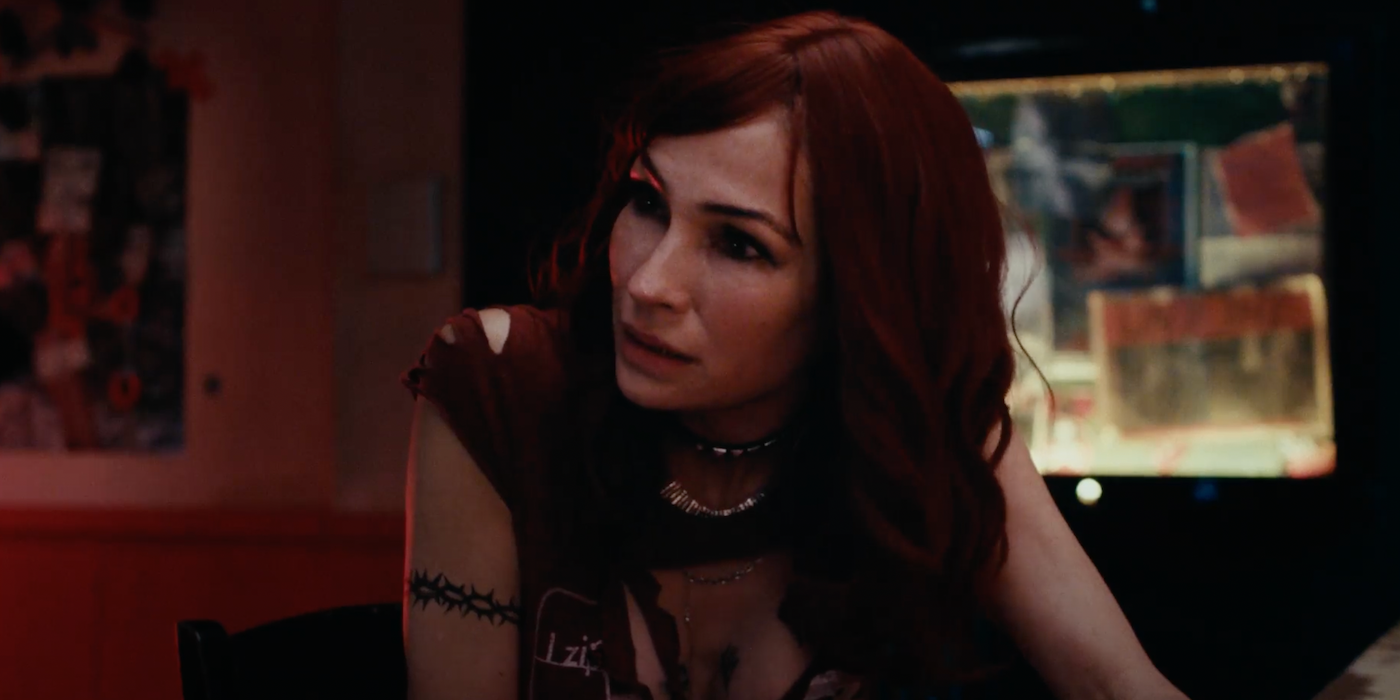On paper, there’s much to love about Door Mouse, Avan Jogia’s (Resident Evil: Welcome to Raccoon City, Zombieland: Double Tap) feature directorial debut. The movie can boast a solid cast, an urban setting infused with punk rock energy, and an art direction that oozes with style. However, Door Mouse's biggest strength is also its biggest flaw. That’s because the movie draws from comic book language to build a mystery story that reflects protagonist Mouse’s (Hayley Law) passion for the medium. While, in theory, that’s a brilliant concept, the comic book structure often hurts the film’s pacing, turning an exciting concept into a challenging viewing experience.
Door Mouse tells the story of Mouse, a young woman who works nights at a burlesque club run by Mama (Famke Janssen), a fierce lady that uses her bar as a refuge for lost girls, where they can be whoever they want to be and make some money out of it. While Mouse puts up exciting shows for the crowd, her dream is to work as a comic book artist. So, after a long morning of sleep, she spends her afternoons drawing horror-porn stories that she tries to sell at the local comic book store. Mouse’s life gets interrupted when one of Mama’s girls mysteriously disappears in the middle of the night, kickstarting an investigation that’ll lead to some gut-wrecking discoveries.
The premise is solid, and it’s clear from the very start how passionate Jogia is about comic books. As the movie goes by, a few frames of comic book drawings overlap the screen, showing how much the careful framing of Door Mouse would fit perfectly on a blank page. The characters and the gritty settings of Door Mouse would also feel at home in Frank Miller’s Sin City universe. However, while the comic book gimmicks help to give the film a unique aesthetic, it also drags the story rhythm down.
While superhero comic books focus on action and fast-paced conflicts, the industry goes beyond Marvel and DC. When it comes to comic books telling investigative stories, the artwork is directed to zoomed-in images and heavy dialogues, while the interior universe of each character bursts on the pages through narration boxes, the only way to explain what a character is feeling with static images. To emulate the comic book feel, Door Mouse also values close shots above anything else, and we constantly hear Mouse narrate her thoughts. And while we can praise Jogia’s commitment to the bit, the strategy also makes Door Mouse lose some of the dynamism of cinema language.
In comic books, the static framing of each scene is a technological limitation, as so far, we haven’t figured out how to make images move on paper. However, comic books have their own charming element to compensate for its restrictions, the gutter, aka the white space between panels. Since each panel represents a static moment in time, the readers’ eyes get trained to fill the blank space between two images with their imagination, making the gutter the magical place where everything can happen. In short, the gutter is what allows us to read comic books and still feel like they are fluid. A movie doesn’t have a gutter because there are no blank spaces between scenes – and thank goodness for that! So, Door Mouse’s static framing contributes to the bothersome sensation the movie is moving slower than it could.
Door Mouse wants to be a comic book so much that Jogia even split the story into six issues, the average size of a story arch in the medium. Over the past few decades, artists have learned to stick to the six-issues formula because it’s easier to refit it into a single graphic novel after the periodical publication, making it a staple in the industry. And just like a graphic novel, each issue of Door Mouse works like an independent chapter, with an introduction that helps the viewer understand the main plot beats, introduces a new challenge, and has a climactic conclusion that leaves a cliffhanger behind to be solved by the next issue.
The episodic structure works wonders for a medium where each chapter hits the store on a monthly basis, but in a movie format, it’s another element that hurts the pacing. A movie is created to be consumed in one go, and the loop of presentation-struggle-climax-cliffhanger makes it harder to remain attached to the story. Maybe Door Mouse would work better as a TV series, where the audience could pause between issues and come back later for a new adrenaline rush when a new climax happens. However, Door Mouse's 2D animated action sequences show how beautiful the story would work in a comic book.
Every time we have a chase or a fight in Door Mouse, the movie shifts from live-action to 2D. These animated scenes contrast with the rest of the movie, as they are fast-paced, bloody, and dynamic. The art style used for the animations checks all the boxes on the list of great comic book art, and as such, they serve as a reminder of how better Door Mouse could feel if we were reading it instead of watching it.
Despite all its flaws, Door Mouse remains an interesting cinematic experiment. And we must commend Jogia for his devotion to comic book language. There are few movies out there that reproduce the feel of reading a comic book so well, and maybe none better than Door Mouse. Still, there’s a reason for that, as different languages demand different artistic choices to keep the public engaged. So, even if Door Mouse proves Jogia is a talented director, each viewer's mileage might vary depending on how much they enjoy the film’s obsession with mimicking comic book language.
Rating: C+
Door Mouse comes to theaters and on-demand on January 13.



